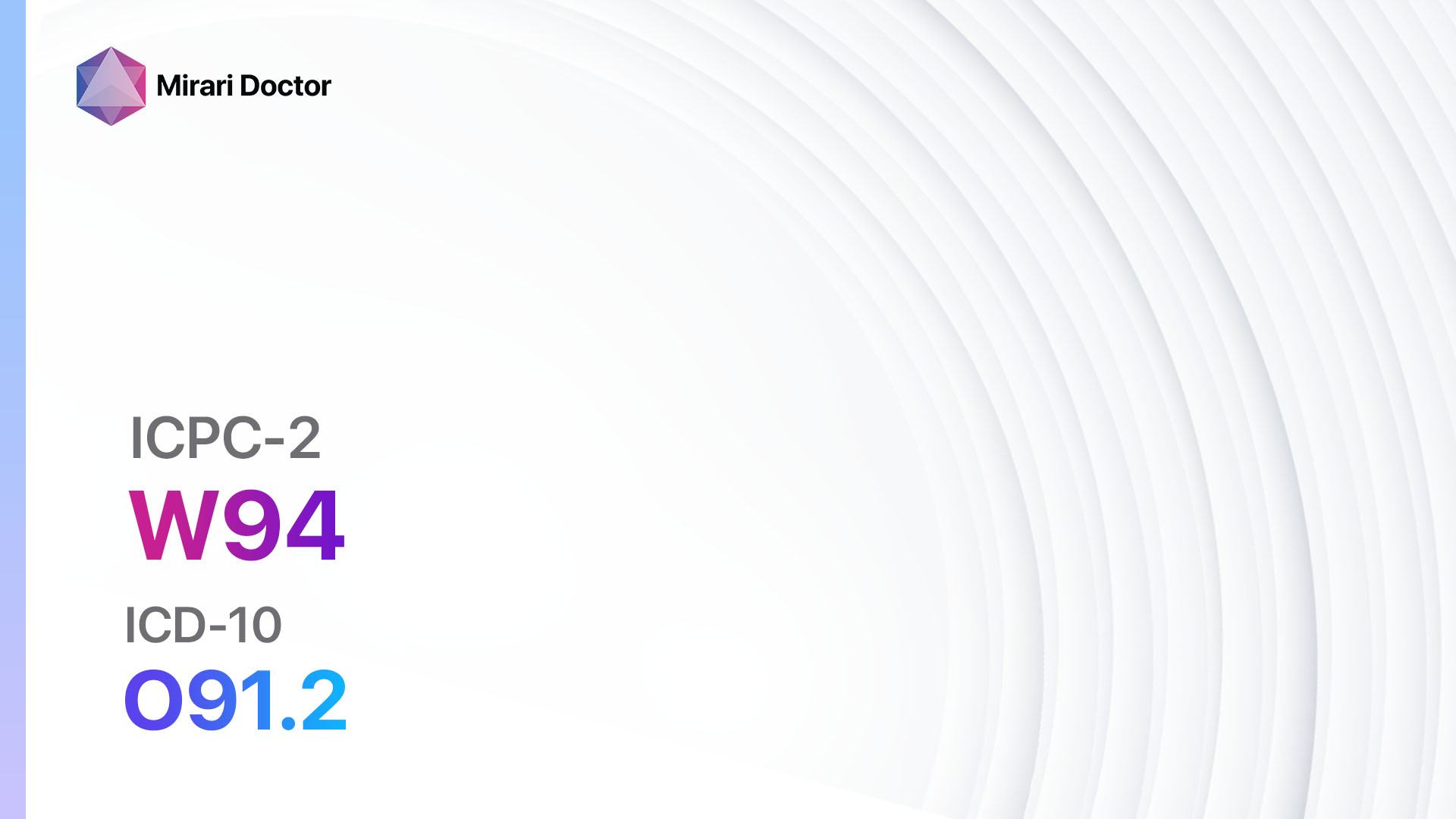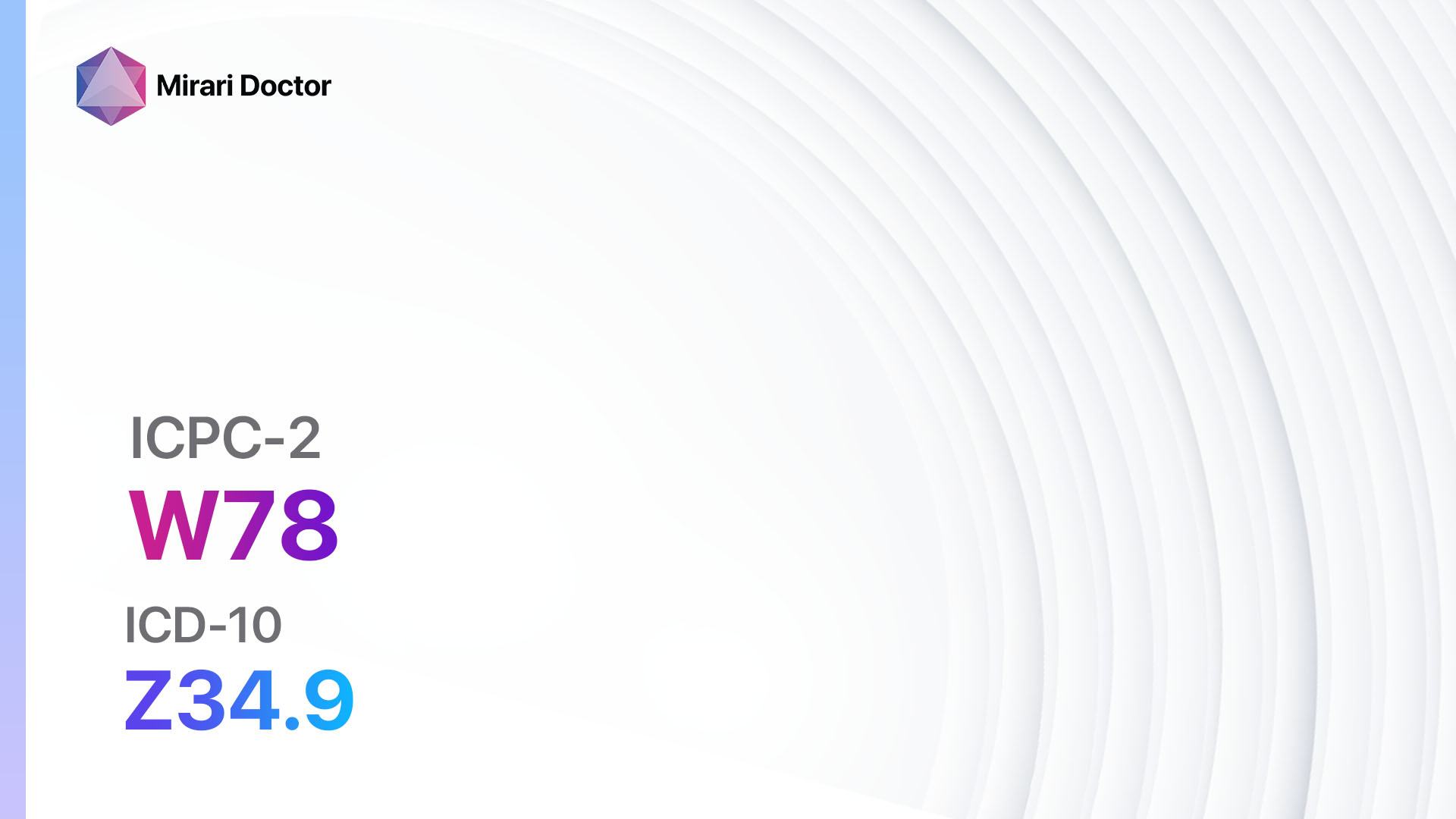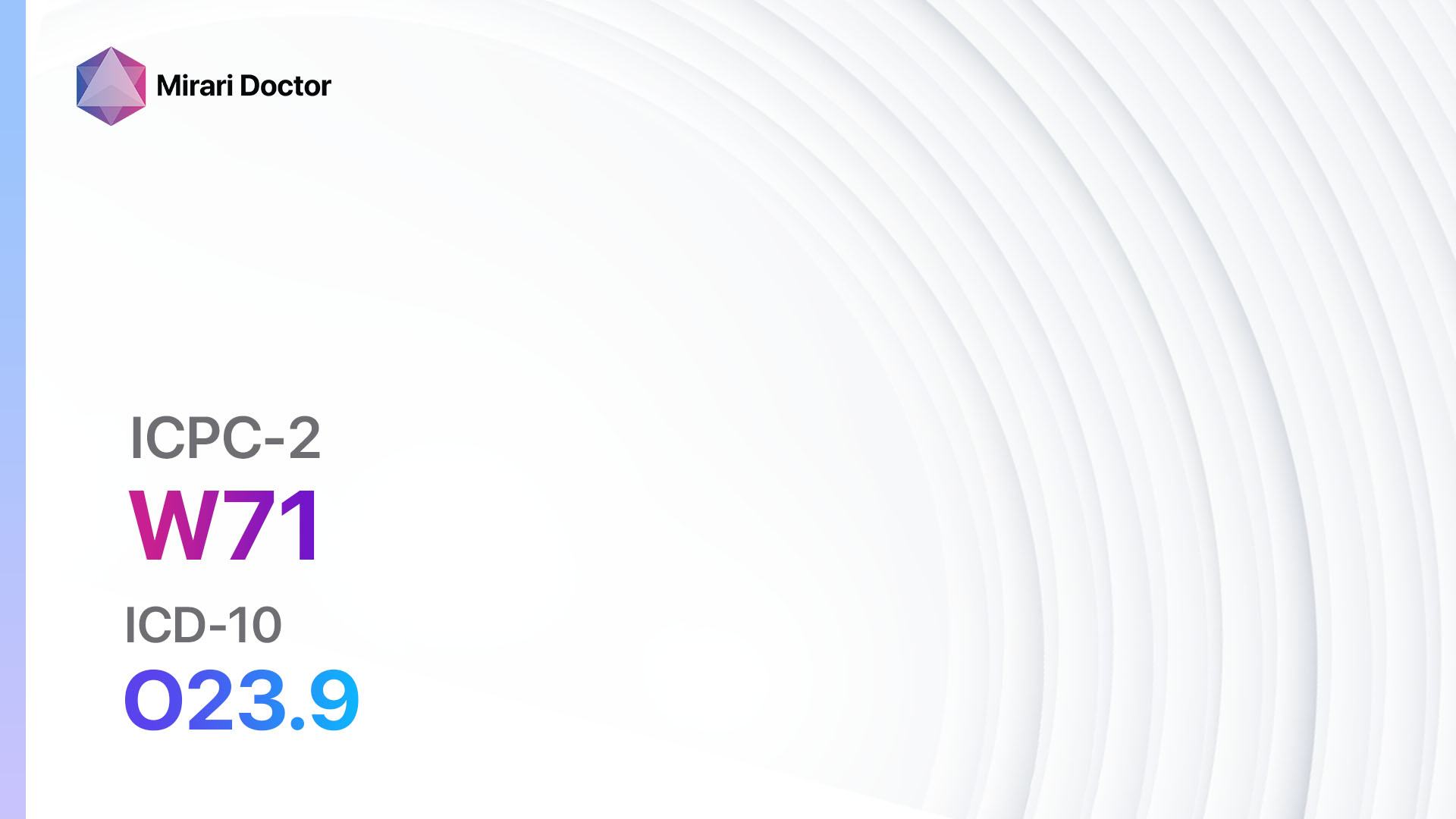
Introduction
Complicated labour/delivery livebirth refers to a situation where there are difficulties or complications during the process of childbirth. These complications can arise due to various factors and can pose risks to both the mother and the baby[1]. The aim of this guide is to provide healthcare professionals with a comprehensive overview of the symptoms, causes, diagnostic steps, possible interventions, and follow-up care for complicated labour/delivery livebirth.
Codes
- ICPC-2 Code: W92 Complicated labour/delivery stillbirth
- ICD-10 Code: O36.4 Maternal care for intrauterine death
Symptoms
- Prolonged labour: Labour lasting longer than 20 hours for first-time mothers or longer than 14 hours for women who have previously given birth.
- Fetal distress: Abnormal heart rate patterns in the baby during labour, indicating potential oxygen deprivation.
- Abnormal presentation: The baby is not positioned head-first in the birth canal, such as breech or transverse presentation.
- Maternal exhaustion: The mother becomes excessively fatigued during labour, leading to decreased progress and potential complications.
- Maternal fever: Elevated body temperature during labour, indicating a possible infection[2][3].
Causes
- Maternal factors: Maternal health conditions such as diabetes, high blood pressure, or obesity can increase the risk of complications during labour.
- Fetal factors: Fetal abnormalities, such as a large baby or abnormal positioning, can contribute to complicated labour.
- Placental factors: Placental abnormalities, such as placenta previa or placental abruption, can lead to complications during labour.
- Uterine factors: Uterine abnormalities or dysfunction can impede the progress of labour.
- Environmental factors: External factors, such as a traumatic birth or inadequate medical care, can contribute to complicated labour[4][5].
Diagnostic Steps
Medical History
- Gather information about the patient’s previous pregnancies and deliveries.
- Assess for any risk factors, such as maternal health conditions or previous complications during labour.
- Inquire about any symptoms or concerns the patient may have related to the current pregnancy[6].
Physical Examination
- Perform a thorough examination of the mother’s abdomen to assess the position and size of the baby.
- Conduct a vaginal examination to assess cervical dilation, effacement, and station.
- Monitor the mother’s vital signs, including blood pressure, heart rate, and temperature.
- Assess for any signs of fetal distress, such as abnormal heart rate patterns or meconium-stained amniotic fluid[7].
Laboratory Tests
- Complete blood count (CBC): To assess for signs of infection or anemia.
- Urinalysis: To screen for urinary tract infections or other abnormalities.
- Blood glucose levels: To evaluate for gestational diabetes.
- Group B streptococcus (GBS) screening: To determine if the mother is a carrier of GBS, which can cause infections in newborns[8].
Diagnostic Imaging
- Ultrasound: To assess fetal position, size, and well-being.
- Magnetic resonance imaging (MRI): In complex cases, an MRI may be used to evaluate the pelvis or fetal abnormalities[9].
- X-rays: In rare cases, X-rays may be used to assess fetal bone abnormalities.
Other Tests
- Non-stress test: Monitors the baby’s heart rate in response to movement.
- Biophysical profile: Combines ultrasound and non-stress testing to assess fetal well-being.
- Amniocentesis: In certain cases, amniotic fluid may be tested for genetic abnormalities or infection[10].
Follow-up and Patient Education
- Schedule regular prenatal visits to monitor the progress of the pregnancy and address any concerns.
- Educate the patient about signs of preterm labor or complications that require immediate medical attention.
- Provide information on childbirth classes and techniques to manage pain and reduce anxiety during labour.
- Discuss the importance of a healthy lifestyle, including proper nutrition and exercise, to promote a successful labour and delivery[1][2].
Possible Interventions
Traditional Interventions
Medications:
Top 5 drugs for Complicated labour/delivery livebirth:
- Oxytocin:
- Cost: $10-$50 per vial.
- Contraindications: Hypersensitivity to oxytocin, abnormal fetal heart rate patterns, placental abnormalities.
- Side effects: Nausea, vomiting, uterine hyperstimulation.
- Severe side effects: Uterine rupture, water intoxication.
- Drug interactions: Nonsteroidal anti-inflammatory drugs (NSAIDs), certain antidepressants.
- Warning: Close monitoring of fetal heart rate and uterine contractions required.
- Magnesium sulfate:
- Cost: $5-$20 per vial.
- Contraindications: Myasthenia gravis, renal failure, heart block.
- Side effects: Flushing, dizziness, muscle weakness.
- Severe side effects: Respiratory depression, cardiac arrest.
- Drug interactions: Neuromuscular blocking agents, calcium channel blockers.
- Warning: Close monitoring of magnesium levels and respiratory status required.
- Analgesics (e.g., opioids):
- Cost: Varies depending on the specific medication.
- Contraindications: Respiratory depression, allergy to opioids.
- Side effects: Sedation, nausea, constipation.
- Severe side effects: Respiratory depression, hypotension.
- Drug interactions: Benzodiazepines, other central nervous system depressants.
- Warning: Use with caution in patients with a history of substance abuse.
- Antibiotics:
- Cost: Varies depending on the specific medication.
- Contraindications: Allergy to antibiotics.
- Side effects: Nausea, diarrhea, allergic reactions.
- Severe side effects: Severe allergic reactions (anaphylaxis), antibiotic resistance.
- Drug interactions: Certain medications may interact with specific antibiotics.
- Warning: Use antibiotics judiciously to prevent antibiotic resistance.
- Corticosteroids:
- Cost: Varies depending on the specific medication.
- Contraindications: Active infections, uncontrolled diabetes.
- Side effects: Increased blood sugar levels, fluid retention, mood changes.
- Severe side effects: Adrenal suppression, osteoporosis.
- Drug interactions: Nonsteroidal anti-inflammatory drugs (NSAIDs), certain anticoagulants.
- Warning: Use corticosteroids cautiously and for a limited duration.
Alternative Drugs:
- Nitroglycerin: Used to relax the uterine muscles and improve blood flow during complicated labour. Cost: $10-$30 per vial.
- Terbutaline: Can be used to relax the uterine muscles and delay preterm labour. Cost: $10-$50 per vial.
- Prostaglandins: Used to ripen the cervix and induce labour in certain cases. Cost: $10-$50 per dose.
- Nifedipine: Can be used to relax the uterine muscles and delay preterm labour. Cost: $10-$30 per vial.
- Epidural anesthesia: Provides pain relief during labour and delivery. Cost: $500-$2000.
Surgical Procedures:
- Cesarean section: In cases where vaginal delivery is not possible or poses risks to the mother or baby. Cost: $15,000 to $50,000.
- Forceps or vacuum-assisted delivery: Assists with the delivery of the baby when there are difficulties during the pushing stage. Cost: $5,000 to $10,000.
Alternative Interventions
- Acupuncture: May help manage pain and promote relaxation during labour. Cost: $60-$120 per session.
- Hypnotherapy: Uses relaxation techniques and visualization to manage pain and reduce anxiety during labour. Cost: $100-$200 per session.
- Water immersion: Immersing in warm water during labour can help manage pain and promote relaxation. Cost: Varies depending on the facility.
- Herbal remedies: Certain herbs, such as raspberry leaf tea or evening primrose oil, are believed to support a healthy labour. Cost: Varies depending on the specific herb and preparation.
Lifestyle Interventions
- Breathing techniques: Teaching the mother various breathing techniques can help manage pain and promote relaxation during labour. Cost: Included in childbirth classes.
- Positioning: Encouraging the mother to change positions during labour can help optimize the progress of labour. Cost: No additional cost.
- Massage: Gentle massage can help relieve pain and promote relaxation during labour. Cost: Varies depending on the provider.
- Hydrotherapy: Using warm water for relaxation and pain relief during labour. Cost: Varies depending on the facility.
It is important to note that the cost ranges provided are approximate and may vary depending on the location and availability of the interventions.
Mirari Cold Plasma Alternative Intervention
Understanding Mirari Cold Plasma
- Safe and Non-Invasive Treatment: Mirari Cold Plasma is a safe and non-invasive treatment option for various skin conditions. It does not require incisions, minimizing the risk of scarring, bleeding, or tissue damage.
- Efficient Extraction of Foreign Bodies: Mirari Cold Plasma facilitates the removal of foreign bodies from the skin by degrading and dissociating organic matter, allowing easier access and extraction.
- Pain Reduction and Comfort: Mirari Cold Plasma has a local analgesic effect, providing pain relief during the treatment, making it more comfortable for the patient.
- Reduced Risk of Infection: Mirari Cold Plasma has antimicrobial properties, effectively killing bacteria and reducing the risk of infection.
- Accelerated Healing and Minimal Scarring: Mirari Cold Plasma stimulates wound healing and tissue regeneration, reducing healing time and minimizing the formation of scars.
Mirari Cold Plasma Prescription
Video instructions for using Mirari Cold Plasma Device – W92 Complicated labour/delivery stillbirth (ICD-10:O36.4)
| Mild | Moderate | Severe |
| Mode setting: 1 (Infection) Location: 2 (Prostate & Uterus) Morning: 15 minutes, Evening: 15 minutes |
Mode setting: 1 (Infection) Location: 2 (Prostate & Uterus) Morning: 30 minutes, Lunch: 30 minutes, Evening: 30 minutes |
Mode setting: 1 (Infection) Location: 2 (Prostate & Uterus) Morning: 30 minutes, Lunch: 30 minutes, Evening: 30 minutes |
| Mode setting: 2 (Wound Healing) Location: 2 (Prostate & Uterus) Morning: 15 minutes, Evening: 15 minutes |
Mode setting: 2 (Wound Healing) Location: 2 (Prostate & Uterus) Morning: 30 minutes, Lunch: 30 minutes, Evening: 30 minutes |
Mode setting: 2 (Wound Healing) Location: 2 (Prostate & Uterus) Morning: 30 minutes, Lunch: 30 minutes, Evening: 30 minutes |
| Mode setting: 2 (Wound Healing) Location: 2 (Prostate & Uterus) Morning: 15 minutes, Evening: 15 minutes |
Mode setting: 2 (Wound Healing) Location: 2 (Prostate & Uterus) Morning: 30 minutes, Lunch: 30 minutes, Evening: 30 minutes |
Mode setting: 2 (Wound Healing) Location: 2 (Prostate & Uterus) Morning: 30 minutes, Lunch: 30 minutes, Evening: 30 minutes |
| Total Morning: 45 minutes approx. $7.50 USD, Evening: 45 minutes approx. $7.50 USD |
Total Morning: 90 minutes approx. $15 USD, Lunch: 90 minutes approx. $15 USD, Evening: 90 minutes approx. $15 USD |
Total Morning: 90 minutes approx. $15 USD, Lunch: 90 minutes approx. $15 USD, Evening: 90 minutes approx. $15 USD |
| Usual treatment for 7-60 days approx. $105 USD – $900 USD | Usual treatment for 6-8 weeks approx. $1,890 USD – $2,520 USD |
Usual treatment for 3-6 months approx. $4,050 USD – $8,100 USD
|
 |
|
Use the Mirari Cold Plasma device to treat Complicated labour/delivery livebirth effectively.
WARNING: MIRARI COLD PLASMA IS DESIGNED FOR THE HUMAN BODY WITHOUT ANY ARTIFICIAL OR THIRD PARTY PRODUCTS. USE OF OTHER PRODUCTS IN COMBINATION WITH MIRARI COLD PLASMA MAY CAUSE UNPREDICTABLE EFFECTS, HARM OR INJURY. PLEASE CONSULT A MEDICAL PROFESSIONAL BEFORE COMBINING ANY OTHER PRODUCTS WITH USE OF MIRARI.
Step 1: Cleanse the Skin
- Start by cleaning the affected area of the skin with a gentle cleanser or mild soap and water. Gently pat the area dry with a clean towel.
Step 2: Prepare the Mirari Cold Plasma device
- Ensure that the Mirari Cold Plasma device is fully charged or has fresh batteries as per the manufacturer’s instructions. Make sure the device is clean and in good working condition.
- Switch on the Mirari device using the power button or by following the specific instructions provided with the device.
- Some Mirari devices may have adjustable settings for intensity or treatment duration. Follow the manufacturer’s instructions to select the appropriate settings based on your needs and the recommended guidelines.
Step 3: Apply the Device
- Place the Mirari device in direct contact with the affected area of the skin. Gently glide or hold the device over the skin surface, ensuring even coverage of the area experiencing.
- Slowly move the Mirari device in a circular motion or follow a specific pattern as indicated in the user manual. This helps ensure thorough treatment coverage.
Step 4: Monitor and Assess:
- Keep track of your progress and evaluate the effectiveness of the Mirari device in managing your Complicated labour/delivery livebirth. If you have any concerns or notice any adverse reactions, consult with your health care professional.
Note
This guide is for informational purposes only and should not replace the advice of a medical professional. Always consult with your healthcare provider or a qualified medical professional for personal advice, diagnosis, or treatment. Do not solely rely on the information presented here for decisions about your health. Use of this information is at your own risk. The authors of this guide, nor any associated entities or platforms, are not responsible for any potential adverse effects or outcomes based on the content.
Mirari Cold Plasma System Disclaimer
- Purpose: The Mirari Cold Plasma System is a Class 2 medical device designed for use by trained healthcare professionals. It is registered for use in Thailand and Vietnam. It is not intended for use outside of these locations.
- Informational Use: The content and information provided with the device are for educational and informational purposes only. They are not a substitute for professional medical advice or care.
- Variable Outcomes: While the device is approved for specific uses, individual outcomes can differ. We do not assert or guarantee specific medical outcomes.
- Consultation: Prior to utilizing the device or making decisions based on its content, it is essential to consult with a Certified Mirari Tele-Therapist and your medical healthcare provider regarding specific protocols.
- Liability: By using this device, users are acknowledging and accepting all potential risks. Neither the manufacturer nor the distributor will be held accountable for any adverse reactions, injuries, or damages stemming from its use.
- Geographical Availability: This device has received approval for designated purposes by the Thai and Vietnam FDA. As of now, outside of Thailand and Vietnam, the Mirari Cold Plasma System is not available for purchase or use.
References
- National Institutes of Health. (2023). What are some common complications during labor and delivery? Retrieved from https://www.nichd.nih.gov/health/topics/labor-delivery/topicinfo/complications
- World Health Organization. (2023). Childbirth: Labour, Delivery and Immediate Postpartum Care. Retrieved from https://www.ncbi.nlm.nih.gov/books/NBK326674/
- Medical News Today. (2022). Labor complications: 10 common problems. Retrieved from https://www.medicalnewstoday.com/articles/307462
- MSD Manual Professional Edition. (2023). Risk Factors for Pregnancy Complications. Retrieved from https://www.msdmanuals.com/professional/gynecology-and-obstetrics/antenatal-complications/risk-factors-for-pregnancy-complications
- Khanam, R., et al. (2014). Risk factors for reported obstetric complications and near misses in rural northwest Bangladesh: analysis from a prospective cohort study. BMC Pregnancy and Childbirth, 14, 347. Retrieved from https://www.ncbi.nlm.nih.gov/pmc/articles/PMC4287506/
- TeachMeObGyn. (2023). The Obstetric History – OSCE – Gravidity – Parity. Retrieved from https://teachmeobgyn.com/history-taking-examinations/history-taking/obstetric/
- GLOWM. (2023). Clinical Assessment of Labor Progress. Retrieved from https://www.glowm.com/article/heading/vol-11–labor-and-delivery–clinical-assessment-of-labor-progress/id/413923
- World Health Organization. (2023). Equipment, Supplies, Drugs and Laboratory Tests. Retrieved from https://www.ncbi.nlm.nih.gov/books/NBK326669/
- NI Direct. (2023). Complicated births and special cases. Retrieved from https://www.nidirect.gov.uk/articles/complicated-births-and-special-cases
- The Lancet Global Health. (2023). Neglected medium-term and long-term consequences of labour and childbirth: a systematic analysis of the burden, recommended practices, and a way forward. Retrieved from https://www.thelancet.com/journals/langlo/article/PIIS2214-109X%2823%2900454-0/fulltext
Related articles
Made in USA



























